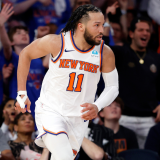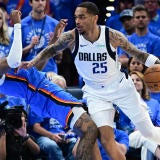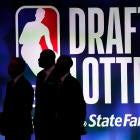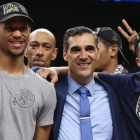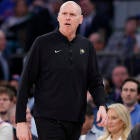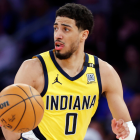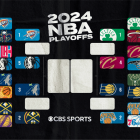The NBA is a 30-team league. It has been a 30-team league for almost two decades, and if Adam Silver is to be believed, it planned to remain a 30-team league for the foreseeable future. Note the past tense of the word "planned," there, because nothing wrecks plans quite like pandemics.
The NBA is absolutely bleeding right now. March estimates suggested a potential billion-dollar loss for the league based only on the coronavirus' impact on this season. If the pandemic stretches on without a vaccine, billions more could be lost in future gate and television revenue. As Silver himself has said, the NBA's financial infrastructure is not built to withstand a prolonged pandemic. Making it through this is going to require cash that the NBA may not have, or may not have the ability to generate through traditional means.
Which brings us back to the league's commitment to a 30-team model. If the NBA is willing to be flexible on the number of teams it puts on the floor, expansion could solve many of its short-term financial issues. With that in mind, let's dive into everything you need to know about expansion both on and off of the court, starting with the enormous economic ramifications of adding new teams.
How does expansion work, and how much money could it raise?
The simplest way to view expansion, from an economic perspective, is to think of it as the sale of a team that does not exist yet. A buyer or a group of buyers purchases a team not from an existing owner, but from the league itself. As the league is nothing more than the 30 teams that make it up, the sale price is split evenly among those 30 teams, and because it is not considered basketball-related income, the teams keep every cent of that money for themselves. Players see none of it, and they have no say in whether or not the league can expand.
The price of an expansion team is not set in stone. Typically, it is a slight inflation of the perceived value of a team in a similar market. The Charlotte Bobcats paid a $300 million expansion fee in 2004. Based purely on potential profit, this was a slight overpay. The Dallas Mavericks were sold for less than that at $285 million only four years earlier despite existing in a stronger market, and the Boston Celtics, one of the league's crown jewels, fetched only $360 million in 2002.
Setting a market price in 2020 comes with some complications, though. Obviously the coronavirus pandemic's impact on the global economy has been pronounced, but the complications surrounding expansion pricing extend further than that.
The last three teams that have changed hands were sold at market-shattering prices. The Los Angeles Clippers and Houston Rockets both sold for at least $2 billion, but perhaps more telling was the $850 million price that the Atlanta Hawks garnered in a relatively modest NBA market. Four years earlier, the Philadephia 76ers fetched only one-third of that price at $280 million with a nearly identical metro population and more concentrated wealth. Five years ago, the NBA was in the middle of a valuation boom, but television ratings have since declined and the pandemic has put the league in a vulnerable position. They certainly wouldn't settle for those early-decade prices, but buyers wouldn't be willing to pay the premium that Steve Ballmer (Clippers) and Tillman Fertitta (Rockets) did, either.
Even given the current economic state of the world, interest is so great that the league would likely draw hefty fees. While the $2 billion figure an anonymous owner gave The Athletic's David Aldridge in 2017 is likely far-fetched, it is not a stretch to suggest $1.5 billion as a starting point. At that price, each team would get a $50 million payout to do with what they saw fit.
What are the downsides for the league?
Remember that slight inflation of market value I mentioned earlier? It comes because the mere presence of a new team lowers the value of any existing ones. Why? Television. Adding a new market adds very little value to the league as a nationally televised product because the primary drivers of ratings, such as the existing big-market teams and the postseason, remain unchanged. But because national television revenue is shared evenly among all teams, those new teams cut into the income every other team would generate even if they aren't creating more of it. There are other revenue streams that are affected similarly, but television is the most important. Think of the new owners as angel investors buying stock in the league as a whole. It infuses cash into the business immediately, but dilutes the long-term earnings for any previous investors.
And then there's the invisible cost of leverage. Leagues prefer to keep a deep stable of possible relocation markets in their back pocket to hold over their existing cities. If one of those cities doesn't want to play ball on a new arena, the NBA can merely point to what happened to Seattle as proof that it isn't bluffing when it threatens to move a team. Filling in the best available markets takes them off the board as leverage. Sending a team back to a preexisting market greatly weakens the league's negotiating power as a whole. What's the harm in losing a team if you can just get a new one in a decade or two?
How would expansion impact the product on the floor?
Cover your ears, children; it's time for the dreaded "D" word. Adding new teams does not expand the existing player pool, so more teams wind up sharing the same amount of talent. That means inevitable talent dilution. Accumulating top players becomes harder for teams when newer competitors for those players arise, but that distribution tends not to be even. Expansion teams tend to serve as roadkill for their contending counterparts. The 1995-96 Chicago Bulls won 72 games, but did so at a point in which six new teams had been added to the league within the previous seven seasons. Servicing all of those new markets wound up fattening the league up for slaughter at the hands of Michael Jordan.
There's also the prospect of realignment. The NBA currently has 30 teams. For the sake of balance, it cannot add a single team. It would be unfair to one conference if the other had fewer competitors, therefore, any expansion plan likely has to account for two new teams. Where those teams fall geographically means quite a bit. As we'll discuss, most of the best expansion markets would make more sense in the Western Conference. To compensate, that could allow for a current Western Conference team to switch over to the East. Minnesota and Memphis both make geographical sense, and moving one of them would cut down on travel time for both themselves and the rest of the league.
And then there's the matter of the schedule. The current system pits each team against their divisional opponents four times, their non-conference opponents twice, and then splits up the remainder of their conference opponents so that they play six of them four times and the remaining four three times. That math falls apart with two more teams.
There are a few ways the league could go about changing that. If, for instance, the idea of cutting games out of the regular season gains any traction, teams could theoretically play each of their non-conference opponents twice and each of their conference opponents three times. That would put a total of 77 games on the schedule. If the league remains squeamish, especially after diluting its revenue, it could add extra games against divisional opponents, or even some form of flexible scheduling to accommodate either a play-in or mid-season tournament.
How do expansion teams fill their rosters?
When new teams are born, the NBA fills them with something called an expansion draft. In this exercise, every team in the NBA is allowed to protect a certain number of its players (in 2004, it was eight). If a team has less than eight players under contract, then it must make at least one player available. Any player left unprotected could then be drafted by the expansion team, but no existing NBA team can lose more than one player. Such rules would be subject to change, but that was the system used for the Bobcats in the league's last expansion draft. Typically, the players made available aren't particularly desirable, but occasional gems slip through the cracks. Gerald Wallace, B.J. Armstrong, Rick Mahorn and Walt Bellamy stand out as some of the biggest names ever selected.
Expansion teams also have picks in the actual NBA Draft. There is no hard-and-fast rule for determining where they select in their inaugural seasons. The then-Vancouver Grizzlies and Toronto Raptors selected No. 6 and No. 7, respectively, in 1995. The Bobcats had the No. 4 pick, but traded up to No. 2. These picks were not awarded in the lottery, but were given out by the commissioner.
Finally, we need to address the cap. Considering their lack of prior financial burdens, the NBA limits how much new teams can spend in order to protect the rest of the league from being easily outbid for free agents. In an expansion team's first season, it can use only 66.7 percent of the cap, and in its second, it can use up to 80 percent of the cap. In its third season, an expansion team has the entire salary cap at its disposal.
How does it impact players?
Players don't technically have a say in the decision to expand, but they hold an unusual amount of leverage at this particular moment. While no expansion decision is remotely imminent, doing so while the league is still sorting through the fallout of COVID-19 would likely require some degree of cooperation from the players due to the inevitable negotiations that will take place over a number of other coronavirus-related concerns.
If the NBA wanted to scrap the CBA-designated method of setting the salary cap in the interest of a short-term alternative, for instance, it would need the players to sign off. There's also the threat of a strike if players and owners ever disagree on the safety of playing during the pandemic. The two sides will have to work closely together on a number of issues over the next several years. A fully unilateral decision to expand likely wouldn't be well-received.
Fortunately, even if the league did decide to expand without communicating with the union, there are several benefits for players who wouldn't have to be collectively bargained. The biggest is the influx of new jobs. Two new teams mean 30 new roster spots and four more two-way slots to be filled. For rank-and-file union members, that could be the difference between remaining in the NBA and heading to Europe, and it would certainly help a number of fringe players reach the necessary three years of service for their pensions to vest. For higher-level players, more teams equals more competition for their services, which theoretically drives up price.
There's also valuable optionality in having more markets in the league. Not only does that mean players have more cities to choose from in free agency, but it creates meaningful stylistic diversity. This is especially important in light of the homogenization of playing styles currently taking place around the league. As teams continue to emphasize shooting, extra franchises mean extra chances for deviation. That deviation creates opportunities for different sorts of players to get paid.
The downsides, though, are potentially significant. While the short-term salary cap is in flux, it will eventually revert to its typical state: a predetermined percentage of projected revenue split equally among every team. New teams do generate new revenue locally, but as we've discussed, have little value on the national stage, so while the league's total revenue would rise with expansion, it would not grow nearly enough to offset the damage of dividing that revenue among 32 teams rather than 30. Put more simply, adding teams lowers the cap.
That impacts players at every level. The maximum salary is defined as a percentage of the cap in a given year. The Mid-Level Exception is based on the average salary in a given year. While the minimum salary is predetermined, a lowered cap limits financial upward mobility through common sense. Teams will always prioritize spending their space on better players, so cutting into cap space would likely force lower-level players to accept minimum deals more readily because there just wouldn't be space available.
While the union would not have the power to demand concessions upon the immediate formation of expansion teams, it could negotiate its way around some of these hurdles. A possible solution to a lower max, for instance, would be to loosen the eligibility restrictions on both "Rose Rule" (prohibits teams from having two designated players on their roster at the same time), and supermax contracts. Both allow players to earn above their designated max by reaching certain criteria. The criteria for each include All-NBA selections, so perhaps the addition of a fourth All-NBA team would offset some of the damage. If the average salary declines, the NBA could offset some of the lost Mid-Level salary by raising the ceiling on other forms of the exception, such as the Tax-Payer- and Cap Room-Mid-Level Exceptions. These are merely suggestions. The overarching point is that the union could solve many of the problems new teams would present while also reaping the benefits those extra jobs created.
What are the likeliest expansion markets?
Broadly speaking, a city needs to hit a few important checkmarks in order to interest the NBA. It needs to either have an NBA-ready arena or the willingness to build one. It needs to hit not only a certain population threshold, but contain enough of a corporate presence to fill luxury boxes and other premium seats. It needs to be a certain distance away from other NBA markets so as not to impede on their territory. And it needs to have some interest in either basketball or at least more professional sports.
That describes at least a dozen cities that don't currently have teams, but four stand out. With apologies to Pittsburgh, Anaheim, Louisville and Virginia Beach, these are the four cities that check the most boxes for the NBA:
Seattle: The city that the NBA left over a decade ago is the one it could potentially return to now for two main reasons. The first is the redevelopment of KeyArena. Seattle was not willing to invest in a stadium in 2007. It is already doing so now even without the guarantee of a franchise. When finished, the new KeyArena will be able to support both an NBA and an NHL team.
Seattle's other major advantage? Its status as a tech hub, led by Amazon. A new team would have no trouble filling its luxury boxes, and while Chris Hansen would be viewed as the heavy front-runner to lead an ownership group, Seattle has so many billionaires in and around the city that the NBA could potentially drum up something of a bidding war for the right to revive the Sonics. Seattle fans have made it perfectly clear that they want a team back. The city has supported NBA basketball before. It is the second-biggest American market without a team right now (behind only Tampa Bay). On paper, this is a slam dunk.
The only concern the NBA might have is setting the precedent that it is willing to send teams back to abandoned markets. If Seattle gets a team back, what would stop any other city from assuming it could lose a team and get it back down the line as well? This would appear to be more of a concern under David Stern than it is under Adam Silver, but it's the only major hiccup in a potential Seattle bid.
Las Vegas: So far, professional sports have flourished in Vegas. The Golden Knights have thrived in T-Mobile Arena (which an NBA team would presumably share), and the Raiders are about to move into a state-of-the-art new stadium. The league already has a foothold in the desert, thanks to summer league and the G League Showcase. Vegas is a relatively small market, beating only New Orleans, Memphis and Oklahoma City in size, but it draws such massive tourism traffic under normal circumstances that filling an arena likely wouldn't be a problem.
But the tourism industry is a double-edged sword. Vegas is getting slammed by the coronavirus because it is almost entirely dependent on tourism revenue. Even if a vaccine is found, it will take the global economy years afterward to recover to the point at which people will have enough disposable income to travel at prior levels. Vegas made perfect sense a year ago. Now? The city is facing so much economic uncertainty that its NBA dreams may no longer be viable.
Kansas City: Another fairly small market, but a potentially valuable one. There isn't another NBA team within 350 miles of Kansas City. A territory that has been casually divided among the Bulls, Pacers, Grizzlies and Thunder could belong to a Kansas City expansion team. The city has a top-notch arena in the Sprint Center just waiting to be filled.
Corporate presence will be Kansas City's greatest challenge. Missouri has a few big ones in its backyard such as Sprint and Anheuser-Busch, but it trails significantly behind Seattle and the Vegas casinos in that way. There is also the question of interest. Yes, the state of Kansas supports its Jayhawks, but the Kings spent over a decade in Kansas City without making much of a dent.
Mexico City: The ultimate wild-card in any expansion talks. Mexico City is the NBA's dream market. It has a bigger population than New York, and a more densely populated one at that. It has a fairly new arena that has hosted NBA games before (albeit with some incidents, including a fire in 2013). International expansion has real momentum right now in light of Toronto's ascension to the top of the league. If a team can succeed in Canada, then theoretically, it could succeed in Mexico.
But for every benefit, there is a major concern. Mexico City is not particularly wealthy. It is not especially safe either. The NBA had trouble convincing players to move to Vancouver. Mexico City would be an even tougher sell. The altitude would create a potentially unfair home-court advantage and perhaps even some medical concerns. Mexico City has the highest upside of any potential expansion market. It also comes with more risk than literally any city that any North American professional sports league has ever expanded into.
So is this going to happen? And if so, when?
Inertia is the most powerful force in sports. Convincing 30 billionaires to try anything new is difficult because, well, they are already billionaires. What they're doing seems to be working. That was largely true in the NBA before this pandemic. While there have been some notable hiccups, revenue continues to rise annually. As recently as a year ago, Silver shot down imminent expansion.
But necessity is the mother of invention, and it cannot be argued how badly the NBA needs cash right now. The league already nearly doubled its line of credit. It cut player salaries by 25 percent for the time being, but that measure is temporary, and even with escrow withholdings and the force majeure clause, it is unlikely that teams will be able to shave enough expenses to offset the massive losses they are currently sustaining. With no vaccine in sight, there is no telling when fans will be able to return to arenas. They account for an estimated 40 percent of league revenue.
Some owners can weather this storm. Steve Ballmer has $50 billion. He is going to be fine. Not every owner is so fortunate. Houston's Tilman Fertitta needed to take out a $300 million loan at a 13 percent interest rate just to keep his restaurant empire afloat, and his purchase of the Rockets in the first place already left him heavily leveraged. Some families that bought their franchises decades ago, including the Buss (Lakers) and Reinsdorf (Bulls and White Sox) ownership groups, lack other significant streams of income outside of professional sports. The same could theoretically be said of Michael Jordan, as premium sneaker sales are likely to decline sharply as well. It's easy to think of owners as a monolith, but the truth of the matter is that their wealth varies wildly and some are significantly better prepared to handle a prolonged loss of revenue than others.
At the moment, it would be naive to assume that expansion is imminent, but it would also be naive to assume that owners aren't considering the prospect. The odds are substantially lower than 50 percent, but the unique circumstances the league now faces ensures that they are higher than zero.
Were the NBA to seriously entertain expansion, the earliest possible timeline would have new teams playing by the 2022-23 season. The Bobcats were announced roughly 18 months before beginning play, but that time frame does not include what were doubtlessly months of negotiations prior. If the NBA is desperate enough, those negotiations could be expedited, but there is no guarantee. Even if the league decided tomorrow that it wanted to expand, it would likely need at least a few months to find buyers, and then more than a year to integrate those new teams into the league.
Even now, it makes sense to characterize this scenario as "unlikely." There are significant long-term costs associated with expansion that most teams would strongly prefer to avoid. But desperate times call for desperate measures. The NBA may never have faced more desperate times than it is now, and if it is seeking a desperate measure to compensate, expansion is by far the best one available.







